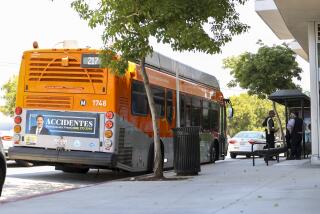$250,000 for Valley Bus Plans OKd
- Share via
Taking another step toward spinning off a separate San Fernando Valley bus district, an alliance of cities approved contracts for $250,000 in planning Monday.
Those fees may not be enough to complete the work for an application to the Metropolitan Transportation Authority seeking to break away a new Valley bus district.
Consultants had anticipated a larger budget of $340,000, which includes a 10% contingency fee.
But Los Angeles County Supervisor Zev Yaroslavsky, a member of the Valley group that wants to form a new transit district, asked consultants to work within a $250,000 limit.
“I want the consultants to look at how they can reduce costs,’ he said. “I don’t want this to be a bottomless pit.”
The MTA, said Yaroslavsky, who also sits on the MTA board, made it clear the agency will not give beyond the $100,000 it has already promised. The balance of $150,000 comes from the city of Los Angeles and the Southern California Assn. of Governments.
The coalition of Valley communities, known formally as the San Fernando Valley Transportation Zone Interim Joint Powers Authority, still had lingering questions about the viability of a separate Valley bus agency.
One of the biggest unanswered questions is anticipated fare-box revenues. Russell Chisholm, president of Transportation Management & Design Inc., the Solana Beach consultants for the interim transit agency, said projected Valley fare-box revenues for its first year of operation were $36 million to $39 million.
But those numbers are preliminary projections, and since then, the Valley has experienced an increase in ridership due to the completion of the Red Line subway and the launch of the successful Rapid Bus route along Ventura Boulevard.
The range in expected revenues was not precise enough to please some members of the interim transit agency.
Member David Fleming asked Chisholm what could be done to coax the MTA into helping come up with more precise projections.
Before a new Valley transit zone moves forward, leaders must also deal with a union that is steadfast in its objections. Goldy Norton, a spokesman for the United Transportation Union, which represents bus and rail operators, said it is unlikely that a breakaway bus zone could be developed under current contracts.
“If you think we went on strike for 32 days to protect our work rules, why would you think we would give them away to a zone?” Norton said after the meeting.
Work rules--which govern work schedules, breaks, seniority perks--are likely to be some of the issues that a Valley transit zone would want to revise while streamlining current MTA standards, transit experts said.
At Monday’s meeting, Norton said he thought it unlikely that there would be another Foothill Transit, itself a breakaway bus agency that formed in 1987.
Foothill Transit split from the MTA’s predecessor, the Rapid Transit District, and has since been able to run a system serving the San Gabriel Valley more cheaply. Foothill Transit achieves those savings in part by paying drivers less and providing fewer benefits.
Chisholm said the next phase of the project--the operational and financial plan--may be completed by June 1.
Yaroslavsky said a new zone will only be created if a cost savings can be demonstrated. “It doesn’t hurt the MTA. It might actually help them,’ he said.
The MTA, he added, could be “liberated” of its onerous responsibility to serve the far-flung Valley.
More to Read
Sign up for Essential California
The most important California stories and recommendations in your inbox every morning.
You may occasionally receive promotional content from the Los Angeles Times.










